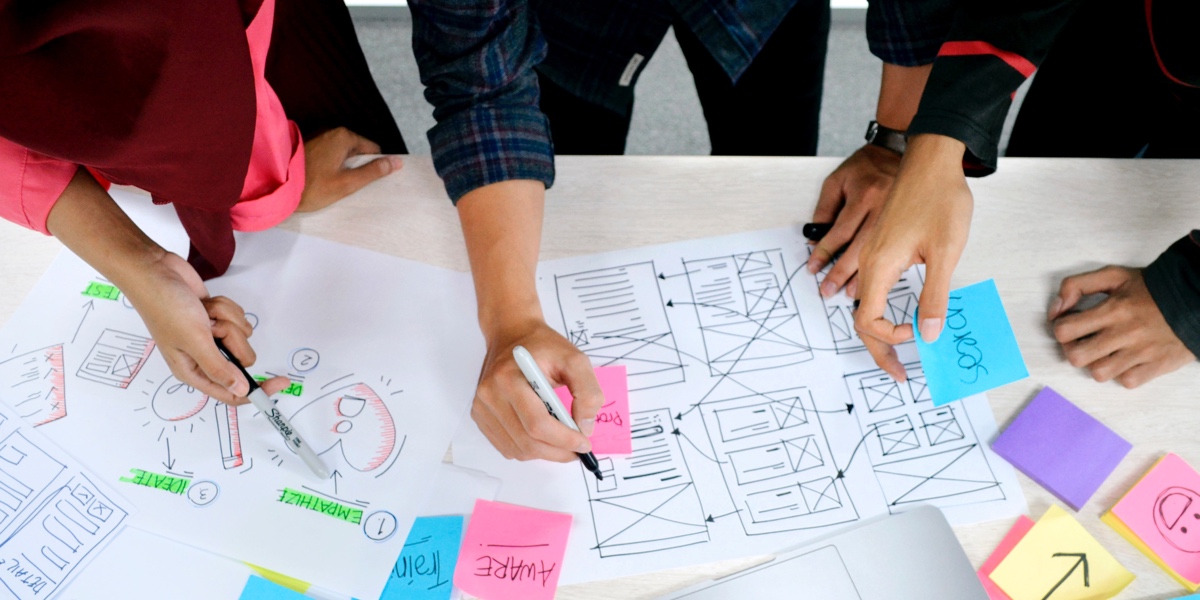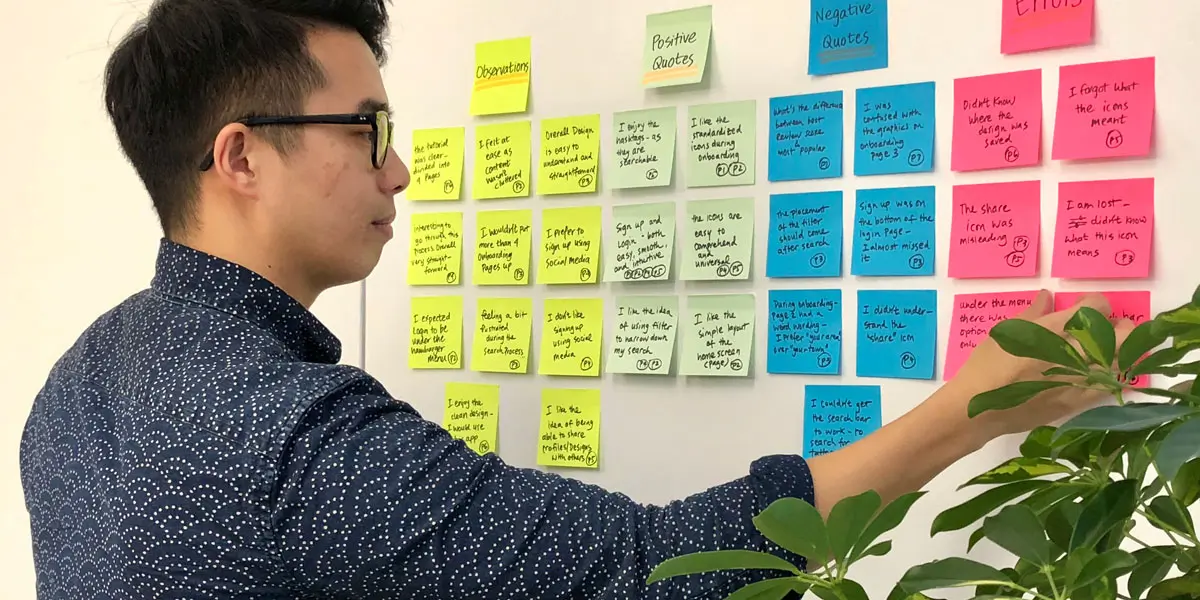If you’re interested in becoming a UX designer, you’ll be curious to know what it’s like on a day-to-day basis. What kinds of tasks can you expect? Who will you work alongside, and what kinds of challenges will you face?
To shed some light, we caught up with recently qualified UX designer Ryan Wu. Prior to becoming a UX designer, Ryan worked as a content specialist at Booking.com. He now works at intive, a design agency (digital agency) with offices around the world.
Here, he talks us through his day as a UX designer. We’ll get an overview of a typical day in the life of a UX designer, as well as some elements and traits that you can expect on a regular basis.
If you’d like to see visually a day in the life of a UX designer, then this video gives you a great opportunity! In it, Maureen shows you a typical workday for her, working remotely in Berlin:
1. AM to PM: A day in the life of a UX designer
AM: To-dos, sprint planning, meetings and Sketch
9am: I usually get to the office around 9am. When I get in, I consult my to-do list, as I normally have a couple of to-dos that I wrote down the day before.
In terms of my workflow, it really depends on the sprint that we’re doing. We work according to an agile Scrum system, so one sprint lasts two weeks. Every two weeks, we’ll dedicate the entire morning to a sprint planning session. We split these into sprint review, demo, planning, and retro. These sessions can take up the whole morning, depending on how much we’ve got to talk about.
Basically we go through the current sprint and talk about what’s happening in the next sprint. As a designer, I need to have everything prepared for the week ahead so that the developers can do their job. That’s my challenge at the moment — it’s hectic, trying to get designs approved! Once the designs are approved, I then need to adapt them to two different platforms, as we’re designing for Android and iOS simultaneously.
11am: At 11am, I have a daily meeting with the development team. This consists of a short Skype call with about twenty people who are mostly located in Szczecin, Poland. Most of them are iOS developers, Android developers, quality assurance and test managers.
11.30am: So, after the daily meeting, I look at what I need to do. At the moment, I’m working in Sketch, iterating on designs and pushing pixels. I’m a product designer, so my role combines both UX and UI design. I wasn’t aware of this before I took the role, but it’s really cool because I get to practice a bit of everything. The same goes for collaborating with the developers; you don’t get that in every job, and I think this is such valuable experience.
1pm: Lunchtime! I usually meal prep in the evenings so for lunch I’ll head to the common area and enjoy my meal there. It’s important to give my eyes a bit of a rest from the screen time, even if it’s just 30 minutes.
PM: Concepting, presentations, feedback and iteration
2pm: I spend a lot of time in and out of the telephone booth speaking with the client. On Tuesdays and Thursdays I have a concepts and alignment meeting with the client. We show them new designs that we’ve come up with, walking them through it via screen sharing. We also have to come prepared to talk about why we made certain design decisions. The client will either say “Hey, I don’t like it” or “Oh, I love this!” Then they’ll most likely ask if we can change this or that — the design is never final! So we continuously iterate based on client and user feedback. Keeping a user centric mindset while designing here is key.
4pm: Once a week we have a roundtable where we (remotely) join the design team in Regensburg. We give a short presentation to show what’s happening, what we’ve worked on in the past week, what challenges we came across, what we learned, any articles we’ve read — it’s all about sharing our designs, getting feedback and avoiding that lapse in communication. It’s important that we stay connected to the design team in Regensburg despite being in different locations.
6pm – Wrapping up: By 6pm, I’m ready to start winding down. At the end of the day, I’ll look at what’s happening tomorrow and write down my to-do list for the next day. I know lots of people write their to-do list first thing in the morning, but I don’t like that. I’ve learned that it’s much less stressful if you just offload your list before you leave work. When I get in the next day, I know exactly what I need to do.

Photo by UX Indonesia on Unsplash
2. A typical day for a UX designer is…
Varied
I work at a digital agency, which means a wide range of clients — from automotive to insurance, fashion, and retail. At the moment I’m working on an app for housing appliances. I’m one of two designers working on this project, and I’m responsible for developing the product; i.e. research, concepting, design, prototyping and testing.
Creative, but systematic
A large part of my role is about developing new concepts. To come up with a new concept, we discuss together as a team. We look at the insights we’ve gathered from user research to find possible solutions for the product, while keeping business goals and user needs in our minds. Since we’re designing something that isn’t the only product for the company, we have to look at existing products to see what kind of styles they use. We have to adapt to that, so while it’s creative, we do have a system that we need to follow.
Collaborative
Clients and product owners
I collaborate with the product owners, as well as with the client. We have a proxy product owner here on our side, and we have a product owner on the client side. It’s all about communicating and getting my designs approved, getting user stories from the product owners and designing in line with their requirements.
Developers
In my role as UX designer, I also work closely with the developers. This was very intimidating at first, but I really value this experience. When I look at different jobs on the market right now, many require this collaboration with developers. I’m responsible for designing something that the developers can build, based on a ticket system. Each ticket has a user story and each user story describes what the developers have to do, and this includes providing visual guidance to show them what the screen should look like and how the elements on the screen should behave. The developers use Zeplin to export all designs and download assets.This is a super important tool for collaboration and documentation! Sometimes, as a designer, you miss something and it’s only brought to your attention during the QA phase. I learn new things every day!
Senior UX designers
When I need feedback or opinions on my designs, I turn to the senior UX designer on the same project, who works in another office. I also have a senior UX designer in the same office as me; he’s my official tutor, and he also supports me on various questions I have about design in general, as well as non-project-related questions.

Photo by Brooke Cagle on Unsplash
Challenging
Working with a global team
Working with a large team which is spread out across different locations can be challenging. Of course it would be easier if I had everyone in-house, but the reality is, we’re all located in different parts of the world, so it’s all about communication. We use Microsoft Teams for internal communication, and GoToMeeting for clients.
Client expectations
One of the biggest challenges in my work as a UX designer is both the product restraints and client expectations. Clients also have stakeholders who they need to make happy, and ultimately we have to listen to what the client wants. We have to focus on the user, sure, but if the client really insists on something, we have to deliver it. That’s the biggest challenge: having to design something even if you think it might not work from a user perspective. That’s where user testing comes in handy. Rapid user testing can help us validate or invalidate design decisions we make without wasting time and development efforts.
But that’s also part of the fun of working at an agency. You get to work for different clients and come up with concepts that they’ll like. Sometimes they won’t like your concept but can’t articulate why, and then you just have to come up with different versions.
This is where it’s crucial to be able to justify your design decisions. Clients view you as the expert, as someone who’s experienced in building apps and knows best practices and understands user behaviour, so they trust you, but they also have their own ideas and visions. They might insist on something and then realise, two months down the line, that it’s not really necessary, and then we go back to square one. That’s just how the cycle works.
Fast-paced
Deadlines
There are various deadlines to meet, especially when it comes to concept alignments with the client. There’s definitely some level of pressure to deliver, as we need to have something to show the client. However, if something is truly impossible to deliver within a given timeframe, we’ll communicate that to the project manager.
Time flies!
The best thing about my day is that the time goes by so fast, it’s incredible! I don’t find myself looking at the clock. I’m looking at my to-do list, learning new tools, discovering new ways of developing products. This is all really new to me, and I’m always learning. I’m given responsibility to deliver and to communicate; no one is babysitting me. I’m really on my own, and this gives me a chance to grow.
Final thoughts
If you like the sound of Ryan’s day, find out what it takes to become a UX designer. Spoiler alert: You don’t need a design degree to start a career in UX, but it’ll definitely be easier if you learn early on what other designs wish they’d known before they got started.
And if you’re curious about a career in UX, but you have little to no industry experience, you’ll find Maureen’s story helpful: How I Became A UX Designer And Got My First Job With No Industry Experience.
Finally, if you’re interested in a career as a remote UX designer, you’ll want to explore the unique perks and challenges that come along with that kind of role. Here are a few guides that will help:
